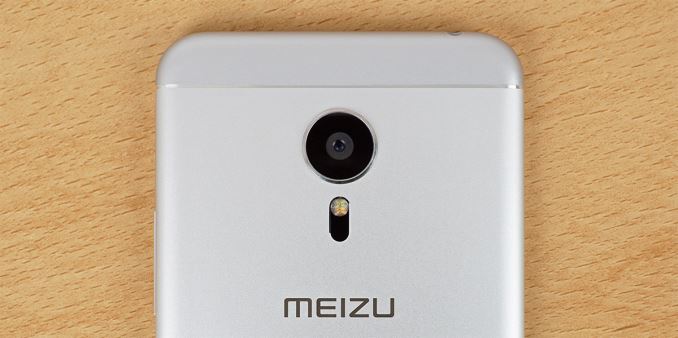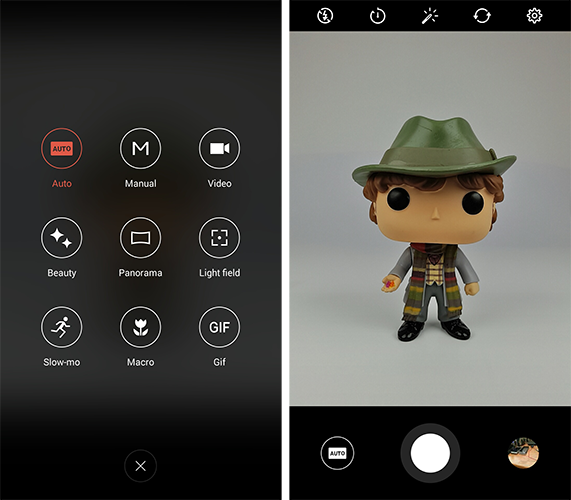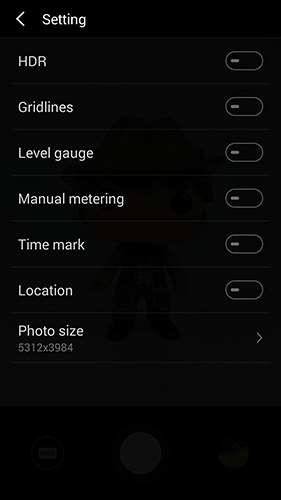The Meizu PRO 5 Review
by Matt Humrick on June 24, 2016 8:00 AM EST- Posted in
- Smartphones
- Exynos
- Mobile
- Meizu
- Exynos 7420
Camera Hardware
The PRO 5’s rear camera uses a Sony IMX230 Exmor RS sensor that captures up to 21MP images with a 4:3 aspect ratio. This is the same sensor used in Motorola’s Moto X Pure Edition, which takes nice pictures in good lighting but struggles a bit in lower-light scenes—partly because of software processing and partly from a lack of optical image stabilization (OIS). The PRO 5 also lacks OIS. We’ll see how this impacts its low-light performance in the next section.
The rear camera’s strength is its hybrid autofocus system that combines phase detect autofocus (PDAF)—using up to 192 AF points on the Sony sensor—laser autofocus, and traditional contrast-based AF as a fallback to provide fast, reliable focusing under a range of lighting conditions. This is still a rare feature; most phones, even the most expensive flagships from Apple and Samsung, only combine two AF methods, either PDAF/contrast or laser/contrast. But combining PDAF and laser makes sense: PDAF works well at longer distances and in good lighting, while laser works well at short distances and in poor lighting.
| Camera Architecture | |
| Meizu PRO 5 | |
| Front Camera: Resolution | 5MP |
| Front Camera: Sensor | OmniVision OV5670 (1.12µm, 1/5") |
| Front Camera: Focal Length | 2.64mm (27mm equivalent) |
| Front Camera: Aperture | f/2.0 |
| Rear Camera: Resolution | 21.16MP |
| Rear Camera: Sensor | Sony IMX230 Exmor RS (1.12µm, 1/2.4") |
| Rear Camera: Focal Length | 4.73mm (27mm equivalent) |
| Rear Camera: Aperture | f/2.2 |
Positioned in front of the rear camera sensor is a 6-element LARGAN lens system that helps improve sharpness near the edges of the image, according to Meizu. The 27mm focal length (35mm equivalent) is fairly typical for smartphone cameras today. Shorter focal lengths increase field of view at the expense of magnification (objects in the image will be comparatively smaller than what is seen by the naked eye for focal lengths less than about 50mm). Because most smartphone cameras lack optical zoom lenses, there’s no way to compensate for the this effect without either compromising image quality by using digital zoom or physically getting closer to the subject. This is why I personally do not like the current trend towards shorter focal lengths.
The lens’ aperture is important, because it determines how much light reaches the sensor. The PRO 5’s f/2.2 lens gives it an aperture area 10% larger than the Huawei P9 and 30% larger than the iPhone 6s Plus; however, its aperture area is 15% smaller than the Nexus 6P and Moto X Pure Edition and 26% smaller than the Galaxy S7, which currently has the largest aperture area of any smartphone. The lack of OIS and an aperture area that’s merely average could hold back the PRO 5’s low-light performance.
The 5MP front-facing camera uses an OmniVision OV5670 sensor, which we’ve also seen in the Asus ZenFone 2. This choice is a little disappointing, because of its small format; smaller sensors capture less light. Many competing phones use 5MP cameras with a 1/4" format and larger 1.4µm pixels.
Camera UX
Meizu’s camera app has a very basic user interface in the default Auto mode. Located along one edge are controls for the flash and timer, along with a toggle to apply various image filters. The HDR control is in the settings menu, which is accessed by tapping the gear icon. With Meizu’s camera app, HDR is either on or off—there’s no automatic HDR mode—so not having an HDR toggle in the main UI is inconvenient.
Tapping the button to the left of the shutter button opens the camera mode selection menu, shown on the left in the screenshot above. Most of the modes are self explanatory. The “Gif” mode, for example, records a six-second video and turns it into a 320x320 animated gif. The “Light field” mode’s label is a bit misleading. It’s actually a selective focus mode that rapidly takes between five to ten pictures at different focal distances. This allows you to change the object in focus later in post-processing. The feature works as intended, but image size is restricted to only 5MP, which significantly degrades quality. It’s also worth noting that the Panorama, Light field, Macro, and Slow-mo modes are not available when using the front-facing camera.
The settings menu is pretty simple, providing control over a few additional features as well as photo and video resolution. There’s an optional level gauge feature that turns the shutter button into a pseudo-bubble-level; however, the level is laggy and inaccurate, making it far less useful than just lining up your shot by using the grid lines. It’s nice to see an option for manual metering, though, which allows you to set focus and exposure points independently.
Meizu’s camera app also provides a manual mode, although it’s not on par with LG’s or Samsung’s. The first issue is that the UI is fixed to portrait mode and does not rotate into landscape mode. This also affects the settings and camera modes menus, which are also portrait only. Another issue, primarily affecting the saturation, contrast, and white balance controls, is that the adjustment slider only offers a few preset values rather than a continuous range of adjustment. This oversight makes these controls next to useless. Finally, there’s no live preview of changes to shutter speed and ISO, which turns image exposure into a guessing game. Because of these flaws, it’s best to just leave the PRO 5 in auto mode and ignore Meizu’s manual mode, correcting any subsequent shortcomings in software later.
No camera app would be complete without beauty and panorama modes. The beauty mode has controls to make your eyes larger, chin slimmer, and skin smooth and pale, but stops short of making you look like a space alien.















80 Comments
View All Comments
Azurael - Friday, June 24, 2016 - link
"The other four phones in this roundup all have OIS and lower resolution sensors. The Mate 8 uses a 16MP Sony IMX298 Exmor RS sensor, while the iPhone 6s Plus, Nexus 6P, and Galaxy S7 all use different 12MP Sony sensors."I had to keep going over that that to make sure I wasn't misreading. I'm fairly certain the Nexus 6P doesn't have OIS...
Matt Humrick - Friday, June 24, 2016 - link
You're right. The Nexus 6P does not have OIS. I've updated the paragraph in the review.Spectrophobic - Saturday, June 25, 2016 - link
I almost thought Anandtech will finally include audio measurements on their phone reviews...Not really a fan of subjectively describing the sound of DACs and amps.
Impulses - Saturday, June 25, 2016 - link
There's a place for both IMO, numbers will never tell the whole story when it comes to audio gear, at least not until we get a lot better at measuring things AND interpreting measurements. Review sites like Innerfidelity have proven this time and again IMO...FWIW AT did include audio measurements for a brief stint when they had some loaner gear, but they don't have access to it anymore and even if they did not every smartphone reviewer would... It's definitely something I'd love to see but the logistics seem tough to figure out.
paradox_cat - Saturday, June 25, 2016 - link
can we please have a HTC 10 review? I'd be interested particularly to see how the sound quality on that compares to this Meizu Pro 5Badelhas - Saturday, June 25, 2016 - link
I would love to read AnandTechs detailed and rigorous full review of the HTC 10 as well but I still like to see these Chinese smartphones reviews as well. Just because I can't buy them except if I import them dosent mean that are a very important part of the competitionBMNify - Saturday, June 25, 2016 - link
Thanks for the review Matt, waiting for Xiaomi Redmi Note 3 and and Mi5. Also try to get the samples for LeEco Le Max2 and LeEco Le2.We are getting all these interesting phones here in India at awesome prices and need a good English review site and you already know you have a sizable Indian readership. Besides, These companies are launching in new markets every few months, so the readership for these devices will only increase in the future.
Valantar - Saturday, June 25, 2016 - link
Another more or less baffling phone review from AnandTech. Not that it isn't slightly interesting to read about uncommon devices and new configurations of known hardware, but given that AT is still missing reviews of all current high end phones save the G5 and the latest iPhone, this is an odd one.Especially given that this device - as stated in the review - won't be very relevant outside of China due to lack of LTE support, this makes me wonder if AT is under some sort of pressure to grow their reader base in China/eastern Asia.
Sure, S7 reviews are a dime a dozen, but none with the technical knowledge and depth of AT reviews. I also get that most AT editors work part time alongside other, time-consuming engagements (like studies), but that's not really an excuse for ever-increasing lateness. If your current editors are overworked, hire more.
m0rdy - Saturday, June 25, 2016 - link
I really don't mind that anandtech's reviews are late, because they're more in depth than any other reviews. Display and colors are SO important to a smartphone, but NO ONE ELSE seems to recognise it and test it as well as Anandtech (not even the manufacturers) ! That's what keeps me coming here. I only wish that the breadth of reviews were greater (i.e. more smartphones)fuicharles - Sunday, June 26, 2016 - link
I also don't mind that anadtech review being late, given it is more in depth, but please don't be too late.